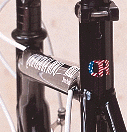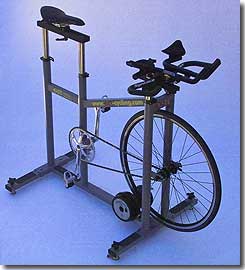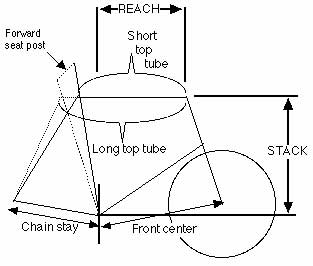Frame sizing problems, Part II: Let’s look at the numbers
The case having been made against T-shirt sizing for bikes — tri in particular — what about numerical sizing? Certain there is more accuracy among bikes using this type of sizing nomenclature.
Well, yes, across one axis, less so across the other. But first, let’s get something straight. There is no place on a tri bike that measures a distance equal to its numerical size. If you ride a 54 centimeter tri bike, you won’t find that it measures 54 centimeters from one meaningful landmark to another. The best thing you can say about a numerical size is that it’s equal to the size of bike you would ride if it was a road bike you were aboard.
Remember that measure of “stack” we tout as an absolute? Stack, you might recall, is the distance in the vertical plane between a bike’s bottom bracket and its head tube top. Here are some samples of common tri bikes that are about equal to each other in height: Trek’s Equinox TTX, Scott’s Plasma and Giant’s Trinity Alliance in size small; the Argon 18 E-112/4 and the Specialized Transition S Works in size medium; and Cervelo’s P3C in size 56cm.
So, there you go, there’s some bikes in the 56cm range, including those in T-shirt sizes that measure out about the same. What about a size up from that?
QR’s 58cm and Felt’s 58cm are exactly the same height, with a stack of 54.5cm. Cervelo’s P2C in that 58cm size is 5mm taller, and the P3C in that size is 10mm shorter. Kestrel’s 59cm Airfoil Pro is the same height as the 58cm P2C. Also, Cannondale’s Slice in its 58mm is right about the same height.
So far, so good. The numerical bikes are closer to reality than the T-shirt sizes are.
But they are wildly variant in length. In that 58cm size we were writing about above, here are some “reach” measures for these bikes and, again, this is the horizontal distance between the BB and the head tube top:
Cannondale Slice, 41.7cm; Kestrel Airfoil Pro, 43.9cm; Cervelo P3C, 44.0cm; Cervelo P3C, 44.5cm; Felt DA, B2, B12, etc., 45cm; QR Kilo and Tequilo, 45.5cm.
So, in this one size, the bikes are very close to one another in height, but range in length from shortest to longest by 5 centimeters. Is this a lot? Imagine a half-dozen road bike manufacturers each making 58cm bikes with 5cm of length difference between them.
The reason you can’t imagine this is because road bikes really have only one place aboard them where you displace your weight, and that place is the saddle. On tri bikes, you can displace your weight on two places: the saddle and the armrest. This gives tri bike makers some fore/aft room to hang themselves (you don’t typically think of people hanging themselves horizontally) and they take advantage of this. Tri bikes therefore exhibit a great range of fore/aft variation, from bike maker to bike maker. That’s a bad thing if you don’t understand the ramifications of this. There is only one way that you properly fit aboard your tri bike, and only one of these longitudinal measures is optimal for you.
The biggest longitudinal jump in this series of bikes is from the Cannondale to everything else. But this should not be taken as evidence that Cannondale is alone in its geometric camp while Kestrel, Cervelo, QR, Felt and the rest of the bike world populate the other. Cannondale has company. Scott’s Plasma in size large has a reach of 41.6cm, about the same ad the C’dale in 58cm. But, then, Giant’s Trinity Alliance in size large has a stack right in line with all these other 58cm bikes, and a reach of 44.9cm, mirroring what we see from Felt and Cervelo.
So, you see, there are two “camps” and we’ll call these the Euro style camp and the North American style camp. Felt, Cervelo, QR, Kestrel, Giant, Jamis, all are “North American” in terms of their triathlon geometry. Scott and Cannondale are more European in their geometric thinking, regardless of their countries of origin.
What other companies are “European” when it comes to their compact (lengthwise) geometries? Colnago, Pinarello, Look, Time and Orbea. But some European companies are more American in their TT geometries: Kuota (specifically the new Kueen K) and Wilier’s new Cento Crono.
What of Trek’s Equinox TTX? It’s right in between . None of its bikes is very long. The reach on the size M is 41.6cm, the same as the Cannondale in 58cm. But it’s lower than the Slice, that is, the same the Trek in size M is the length of the Slice in size 58cm, but it’s the height of the Slice in the 56cm size.
As opposed to bikes with T-shirt sizes, bikes with numerical sizing are quite uniform, one to another, in the arena of height. The great variance is in the bike’s length. If you took all your parts off one of these bikes and placed them on the other, the height of the bike would be pretty close, but you might have to swap the stem out for another of a quite different length — especially if you’re moving your parts not just across bikes, but across the Atlantic, stylistically speaking.





Start the discussion at slowtwitch.northend.network